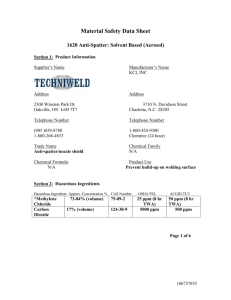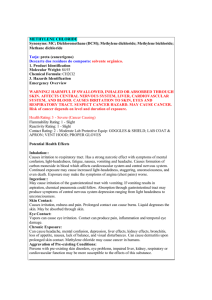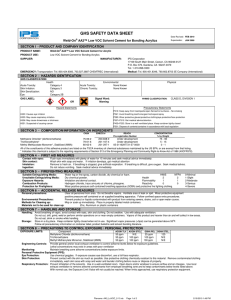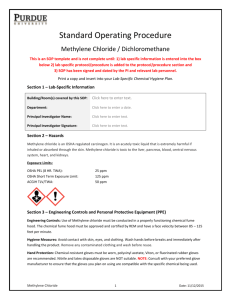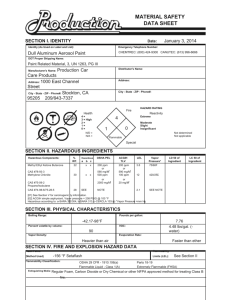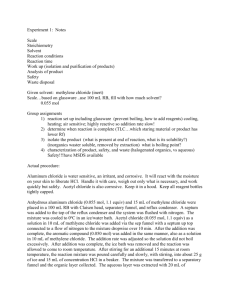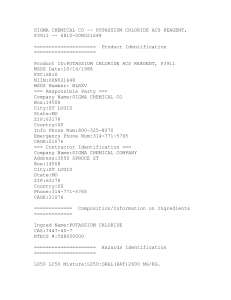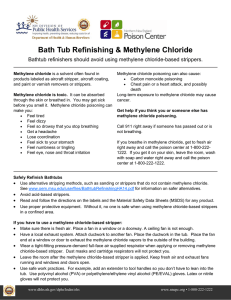MATERIAL SAFETY DATA SHEET IPS
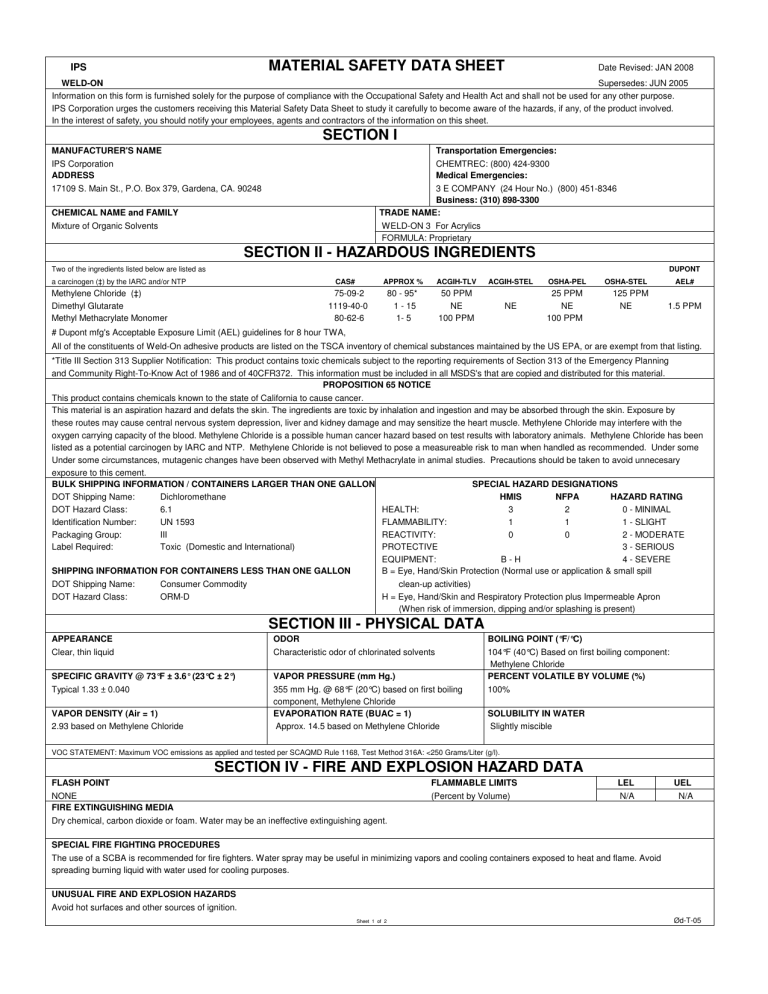
IPS
WELD-ON Supersedes: JUN 2005
Information on this form is furnished solely for the purpose of compliance with the Occupational Safety and Health Act and shall not be used for any other purpose.
IPS Corporation urges the customers receiving this Material Safety Data Sheet to study it carefully to become aware of the hazards, if any, of the product involved.
In the interest of safety, you should notify your employees, agents and contractors of the information on this sheet.
SECTION I
MANUFACTURER'S NAME Transportation Emergencies:
IPS Corporation
ADDRESS
17109 S. Main St., P.O. Box 379, Gardena, CA. 90248
CHEMTREC: (800) 424-9300
Medical Emergencies:
3 E COMPANY (24 Hour No.) (800) 451-8346
Business: (310) 898-3300
TRADE NAME: CHEMICAL NAME and FAMILY
Mixture of Organic Solvents WELD-ON 3 For Acrylics
FORMULA: Proprietary
SECTION II - HAZARDOUS INGREDIENTS
Two of the ingredients listed below are listed as a carcinogen (‡) by the IARC and/or NTP
Methylene Chloride (‡)
Dimethyl Glutarate
Methyl Methacrylate Monomer
MATERIAL SAFETY DATA SHEET
CAS# APPROX %
75-09-2 80 - 95*
1119-40-0 1 - 15
80-62-6 1- 5
ACGIH-TLV
50 PPM
NE
100 PPM
ACGIH-STEL
NE
OSHA-PEL
25 PPM
NE
100 PPM
Date Revised: JAN 2008
OSHA-STEL
125 PPM
NE
DUPONT
AEL#
1.5 PPM
# Dupont mfg's Acceptable Exposure Limit (AEL) guidelines for 8 hour TWA,
All of the constituents of Weld-On adhesive products are listed on the TSCA inventory of chemical substances maintained by the US EPA, or are exempt from that listing.
*Title III Section 313 Supplier Notification: This product contains toxic chemicals subject to the reporting requirements of Section 313 of the Emergency Planning and Community Right-To-Know Act of 1986 and of 40CFR372. This information must be included in all MSDS's that are copied and distributed for this material.
PROPOSITION 65 NOTICE
This product contains chemicals known to the state of California to cause cancer.
This material is an aspiration hazard and defats the skin. The ingredients are toxic by inhalation and ingestion and may be absorbed through the skin. Exposure by these routes may cause central nervous system depression, liver and kidney damage and may sensitize the heart muscle. Methylene Chloride may interfere with the oxygen carrying capacity of the blood. Methylene Chloride is a possible human cancer hazard based on test results with laboratory animals. Methylene Chloride has been listed as a potential carcinogen by IARC and NTP. Methylene Chloride is not believed to pose a measureable risk to man when handled as recommended. Under some
Under some circumstances, mutagenic changes have been observed with Methyl Methacrylate in animal studies. Precautions should be taken to avoid unnecesary exposure to this cement.
BULK SHIPPING INFORMATION / CONTAINERS LARGER THAN ONE GALLON
DOT Shipping Name:
DOT Hazard Class:
Identification Number:
Packaging Group:
Label Required:
Dichloromethane
6.1
UN 1593
III
Toxic (Domestic and International)
HEALTH:
SPECIAL HAZARD DESIGNATIONS
FLAMMABILITY:
REACTIVITY:
PROTECTIVE
HMIS
3
1
0
NFPA
2
1
0
HAZARD RATING
0 - MINIMAL
1 - SLIGHT
2 - MODERATE
3 - SERIOUS
SHIPPING INFORMATION FOR CONTAINERS LESS THAN ONE GALLON
DOT Shipping Name:
DOT Hazard Class:
Consumer Commodity
ORM-D
EQUIPMENT: B - H 4 - SEVERE
B = Eye, Hand/Skin Protection (Normal use or application & small spill
clean-up activities)
H = Eye, Hand/Skin and Respiratory Protection plus Impermeable Apron
APPEARANCE
Clear, thin liquid
SPECIFIC GRAVITY @ 73°F ± 3.6° (23°C ± 2°)
(When risk of immersion, dipping and/or splashing is present)
SECTION III - PHYSICAL DATA
ODOR
Characteristic odor of chlorinated solvents
VAPOR PRESSURE (mm Hg.)
BOILING POINT (°F/°C)
104°F (40°C) Based on first boiling component:
Methylene Chloride
PERCENT VOLATILE BY VOLUME (%)
Typical 1.33 ± 0.040 100%
VAPOR DENSITY (Air = 1)
2.93 based on Methylene Chloride
355 mm Hg. @ 68°F (20°C) based on first boiling
component, Methylene Chloride
EVAPORATION RATE (BUAC = 1)
Approx. 14.5 based on Methylene Chloride
SOLUBILITY IN WATER
Slightly miscible
VOC STATEMENT: Maximum VOC emissions as applied and tested per SCAQMD Rule 1168, Test Method 316A: <250 Grams/Liter (g/l).
SECTION IV - FIRE AND EXPLOSION HAZARD DATA
FLASH POINT FLAMMABLE LIMITS
NONE
FIRE EXTINGUISHING MEDIA
Dry chemical, carbon dioxide or foam. Water may be an ineffective extinguishing agent.
(Percent by Volume)
LEL
N/A
UEL
N/A
SPECIAL FIRE FIGHTING PROCEDURES
The use of a SCBA is recommended for fire fighters. Water spray may be useful in minimizing vapors and cooling containers exposed to heat and flame. Avoid spreading burning liquid with water used for cooling purposes.
UNUSUAL FIRE AND EXPLOSION HAZARDS
Avoid hot surfaces and other sources of ignition.
Sheet 1 of 2
Ød-T-05
SECTION V - HEALTH HAZARD DATA
PRIMARY ROUTES
OF ENTRY: X Inhalation X Skin Contact Eye Contact Ingestion
EFFECT OF OVEREXPOSURE
ACUTE:
Inhalation: Exposure to vapors may result in nausea, drowsiness, dizziness, headache, fatigue, other CNS effects and heart arrhythmias (irregular
Skin Contact: heart beats). Can cause irritation of eyes and nasal passages. Exposure to high concentrations may impair blood's ability to transport oxygen.
Prolonged or repeated exposure to vapors may cause liver and kidney damage.
Repeated or prolonged contact may result in defatting of skin, irritation, contact dermatitis, rash, itching, swelling. May be absorbed through skin.
Eye Contact:
Ingestion:
Direct exposure may result in irritation with corneal or conjuctival inflammation if not removed promptly. Vapors may irritate eyes.
Moderately toxic. Irritant to digestive tract, may induce signs of central nervous system depression. Do not induce vomiting and obtain prompt medical attention.
CHRONIC:
Inhalation ‡ This material is an aspiration hazard and defats the skin. The ingredients are toxic by inhalation and ingestion and may be absorbed through the skin. Exposure through these routes may cause central nervous system depression, liver and kidney damage and may sensitize the heart muscle. Methylene Chloride may interfere with the oxygen carrying capacity of the blood. Methylene Chloride is a possible human cancer based on test results with laboratory animals. Methylene Chloride has been listed as a potential carcinogen by IARC and NTP. Methylene Chloride is not believed to pose a measureable risk to man when handled as recommended. Under some circumstances, mutagenic changes have been observed with Methyl Methacrylate in animal studies. Precautions should be taken to avoid unnecesary exposure to this cement.
Ingestion Ingestion of alcohol may increase the potential for development of toxic effects or reactions resulting from Methylene Chloride exposure.
REPRODUCTIVE EFFECTS TERATOGENICITY MUTAGENICITY EMBRYOTOXICITY SENSITIZATION TO PRODUCT SYNERGISTIC PRODUCTS
N. AP.
POSS.
N. AP.
POSS.
N. AP.
N. AV.
MEDICAL CONDITIONS AGGRAVATED BY EXPOSURE: This material may aggravate an existing dermatitis. Individuals with pre-existing diseases of the heart,
liver or kidney may have increased susceptibility to the toxicity of excessive exposures.
EMERGENCY AND FIRST AID PROCEDURES
Inhalation: Remove patient to fresh air and if breathing stopped, give artificial respiration. If breathing is difficult, give oxygen. Contact physician immediately.
Eye Contact:
Skin Contact:
Ingestion:
Immediately flush eyes with flowing water for 15 minutes and contact a physician.
Wash skin with soap and water. Remove contaminated clothing and shoes. Launder clothing before reuse. If irritation develops, get medical attention.
Give 1 or 2 glasses of water or milk. Do not induce vomiting. Call physician or poison control center immediately.
SECTION VI - REACTIVITY
STABILITY UNSTABLE
STABLE X
CONDITIONS TO AVOID: Stable under normal conditions of storage and handling. Avoid contact or ex-
posure to fire, heat, sparks, electric arcs, open flame and hot surfaces which can cause thermal decomposition.
INCOMPATIBILITY
(MATERIALS TO AVOID) Strong alkalies, oxygen, nitrogen, peroxide, potassium and reactive metals.
HAZARDOUS DECOMPOSITION PRODUCTS
This product gives out carbon monoxide (CO), carbon dioxide (CO²), Phosgene gas and smoke upon combustion or contact with reactive metals.
HAZARDOUS
POLYMERIZATION
MAY OCCUR
WILL NOT OCCUR X
CONDITIONS TO AVOID
Keep away from heat, sparks, open flame and other sources of ignition.
SECTION VII - SPILL OR LEAK PROCEDURES
STEPS TO BE TAKEN IN CASE MATERIAL IS RELEASED OR SPILLED
Evacuate area, ventilate and avoid breathing vapors. Dike area to contain spill. Clean up area (wear protective equipment) by mopping or with absorbent material and place in closed containers for disposal. Avoid contamination of ground and surface waters. Do not flush to sewer. If spill occurs indoors, turn off heating and/or air conditioning systems to prevent vapors from contaminating entire building.
WASTE DISPOSAL METHOD
Recovered liquids may be sent to a licensed reclaimer or incineration facility. Contaminated material must be disposed of in a permitted solid waste management facility.
Follow local, State and Federal regulations. Material should not be allowed to drain into domestic sewer or storm drains. Consult disposal expert.
SECTION VIII - SPECIAL PROTECTION INFORMATION
RESPIRATORY PROTECTION (Specify type)
Atmospheric levels should be maintained below established exposure limits contained in Section II. If airborne concentrations exceed those limits, use of a NIOSH approved positive-pressure, full-facepiece SCBA or positive-pressure, full-facepiece supplied air respirator (with an auxiliary positive pressure SCBA) is recommended.
Even for emergency and other conditions where short term exposure guidelines may/may not be exceeded, use of an approved positive pressure self-contained breathing apparatus (SCBA) is recommended.
VENTILATION
Use only with adequate ventilation. Do not use in close quarters or confined spaces. Open doors and/or windows to ensure airflow and air changes. Use local exhaust ventilation to remove airborne contaminants from employee breathing zone and to keep contaminants below 25 ppm TWA. Use only explosion-proof ventilation equipment.
Monitoring should be performed to determine exposure level(s) IAW (in accordance with) 29 CFR 1910.1052.
PROTECTIVE GLOVES PVA coated or Latex-Nitrile rubber. Surgical gloves or EYE PROTECTION Splashproof chemical goggles, face shield, safety solvent resistant barrier creme should provide adequate protection in normal usage. glasses with brow guards and side shields, etc. as appropriate for exposure.
OTHER PROTECTIVE EQUIPMENT AND HYGIENIC PRACTICES
Impervious apron and a source of running water to flush or wash the eyes and skin in case of contact.
SECTION IX - SPECIAL PRECAUTIONS
PRECAUTIONS TO BE TAKEN IN HANDLING AND STORING
Store in a shaded place below 80°F (27°C) . Keep away from all sources of heat, sparks, open flame and other sources of ignition. Close container after each use.
Use with adequate ventilation. Avoid contact with eyes, skin and clothing. Train employees on all special handling procedures before they work with this product.
OTHER PRECAUTIONS
Follow all precautionary information given on container label, product bulletins and our solvent cementing literature. All material handling equipment should be electrically grounded.
The information contained herein is based on data considered accurate. However, no warranty is expressed or implied regarding the accuracy of this data or the results to be obtained from the use thereof.
Sheet 2 of 2
Ød-T-05
